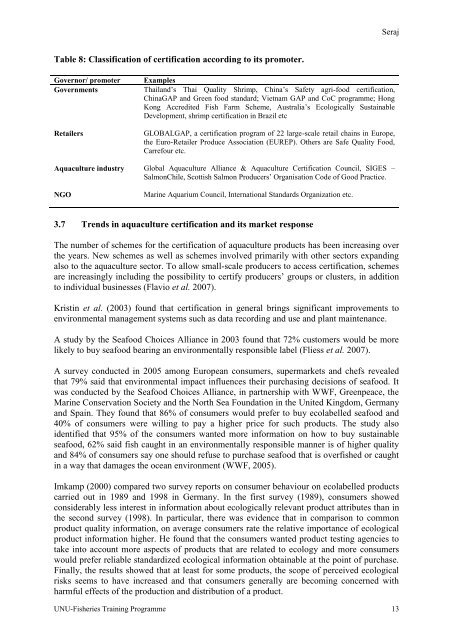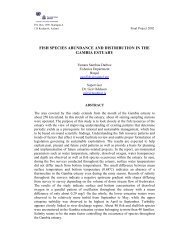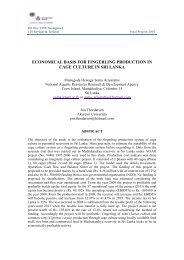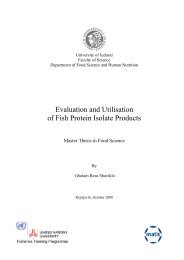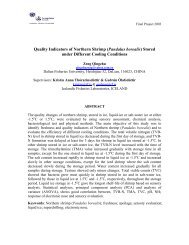SerajTable 7 : Examples <strong>of</strong> principles and codes <strong>of</strong> conduct relevant to <strong>aquaculture</strong>certificationDocumentFAO Code <strong>of</strong> Conduct forResponsible FisheriesInternational Principle forResponsible Fish FarmingFAO, NACA, UNEP, WWF andWorld BankGAA Code <strong>of</strong> Good PracticesFEAP Code <strong>of</strong> Conduct forEuropean AquacultureCodex AlimentariusISEAL Code <strong>of</strong> Good practiceFAO Guidelines for Ecolabelling<strong>of</strong> Fish and Fishery Productsfrom Marine Capture FisheriesFAO Guidelines for Aquaculturecertification<strong>The</strong> UN Global CompactPrinciplesDescription<strong>The</strong> CCRF was developed by the FAO in 1995. It is considered a fundamentalframework for national and international efforts towards the sustainability <strong>of</strong> thefisheries and <strong>aquaculture</strong> sector. Article 9 and 11 describe the sustainable <strong>aquaculture</strong>development and certification matters (Annexure: 3).This document was developed in 2006 through a consortium formed by the FAO,NACA, UNEP, WWF and World Bank. <strong>The</strong> purpose <strong>of</strong> these principles is to provideguidance on the implementation <strong>of</strong> the FAO Code <strong>of</strong> Conduct for ResponsibleFisheries in the <strong>shrimp</strong> <strong>aquaculture</strong> sector. It considers the technical, environmental,social and economic issues associated with <strong>shrimp</strong> farming and provides a basis forimproving the overall sustainability <strong>of</strong> <strong>shrimp</strong> farming .<strong>The</strong>re are eight principleswithin (i) site <strong>of</strong> farms, (ii) design and construction <strong>of</strong> farms, (iii) minimizing theimpact <strong>of</strong> water use (iv) responsible use <strong>of</strong> broodstock and postlarvae, (v) efficient use<strong>of</strong> feeds and feed management, (vi) good health management, (vii) ensuring foodsafety and the quality <strong>of</strong> <strong>shrimp</strong> products, and (viii) social responsibility(FAO/NACA/UNEP/WWF 2006).This Code <strong>of</strong> Good Practice was developed in 1999 by the Global AquacultureAlliance (GAA) based on the FAO Code <strong>of</strong> Conduct. It has been further developed inrecent years. It serves as the basis for th e Good Aquaculture Practices (GAP)certification scheme <strong>of</strong> the Aquaculture Certification Council (ACC).This code <strong>of</strong> conduct was developed by FEAP (Federation <strong>of</strong> European AquacultureProducers) in 1999. <strong>The</strong> objective was to promote the responsible development andmanagement <strong>of</strong> the European <strong>aquaculture</strong> sector in order to assure production <strong>of</strong> ahigh standard <strong>of</strong> quality food addressing environmental considerations and consumers’demands (Consensus, 2008).<strong>The</strong> Codex Alimentarius is a collection <strong>of</strong> food safety standards, codes <strong>of</strong> practice,guidelines and other recommendations developed under the guidance <strong>of</strong> the CodexAlimentarius Commission. Codex provisions concern the hygienic and nutritionalquality <strong>of</strong> food, including microorganisms, pesticides and veterinary drug residues,contaminants, labelling and presentation, and methods <strong>of</strong> sampling and risk analysis.<strong>The</strong>re are about 200 Codex Standards, <strong>of</strong> which several are applicable to fisheriescommodities, and over 100 other documents including Codes <strong>of</strong> Practice andguidelines.<strong>The</strong> ISEAL (International Social and Environmental Accreditation and LabellingAlliance) Code <strong>of</strong> Good Practice is the international reference for setting crediblevoluntary social and environmental standards. It is referenced by a range <strong>of</strong>governmental and inter-governmental guidelines as the measure <strong>of</strong> credibility forvoluntary social and environmental standards.<strong>The</strong> guidelines are applicable to ecolabelling schemes that certify marine fisheries.<strong>The</strong> guidelines refer to principles, general considerations and minimum substantiverequirements and procedural and institutional aspects <strong>of</strong> ecolabelling schemes.Recently, the FAO in collaboration with NACA (Network for Aquaculture Centres inAsia and the Pacific) has developed the guidelines for <strong>aquaculture</strong> certification. <strong>The</strong>guidelines describe governance process and principles, general considerations andminimum substantive requirements for setting standards for certification schemes.<strong>The</strong> UN Global Compact has set principles to promote issues <strong>of</strong> human rights, labourstandards, the environment and corruption. It comprises ten principles on (i) humanrights (ii) labour standard (iii) environment and (iv) anti-corruption3.6 Classification <strong>of</strong> <strong>aquaculture</strong> certification schemesFlavio et al. (2007) found at least 30 schemes and eight key international agreements relevantto <strong>aquaculture</strong> certification in 2007. <strong>The</strong>y grouped certifying schemes as follows (Table 8) onthe basis <strong>of</strong> promoting organisation.UNU-Fisheries Training Programme 12
SerajTable 8: Classification <strong>of</strong> certification according to its promoter.Governor/ promoterGovernmentsRetailersExamplesThailand’s Thai Quality Shrimp, China’s Safety agri-food certification,ChinaGAP and Green food standard; Vietnam GAP and CoC programme; HongKong Accredited Fish Farm Scheme, Australia’s Ecologically SustainableDevelopment, <strong>shrimp</strong> certification in Brazil etcGLOBALGAP, a certification program <strong>of</strong> 22 large-scale retail chains in Europe,the Euro-Retailer Produce Association (EUREP). Others are Safe Quality Food,Carrefour etc.Aquaculture industry Global Aquaculture Alliance & Aquaculture Certification Council, SIGES –SalmonChile, Scottish Salmon Producers’ Organisation Code <strong>of</strong> Good Practice.NGOMarine Aquarium Council, International Standards Organization etc.3.7 Trends in <strong>aquaculture</strong> certification and its market response<strong>The</strong> number <strong>of</strong> schemes for the certification <strong>of</strong> <strong>aquaculture</strong> products has been increasing overthe years. New schemes as well as schemes involved primarily with other sectors expandingalso to the <strong>aquaculture</strong> sector. To allow small-scale producers to access certification, schemesare increasingly including the possibility to certify producers’ groups or clusters, in additionto individual businesses (Flavio et al. 2007).Kristin et al. (2003) found that certification in general brings significant improvements toenvironmental management systems such as data recording and use and plant maintenance.A <strong>study</strong> by the Seafood Choices Alliance in 2003 found that 72% customers would be morelikely to buy seafood bearing an environmentally responsible label (Fliess et al. 2007).A survey conducted in 2005 among European consumers, supermarkets and chefs revealedthat 79% said that environmental impact influences their purchasing decisions <strong>of</strong> seafood. Itwas conducted by the Seafood Choices Alliance, in partnership with WWF, Greenpeace, theMarine Conservation Society and the North Sea Foundation in the <strong>United</strong> Kingdom, Germanyand Spain. <strong>The</strong>y found that 86% <strong>of</strong> consumers would prefer to buy ecolabelled seafood and40% <strong>of</strong> consumers were willing to pay a higher price for such products. <strong>The</strong> <strong>study</strong> alsoidentified that 95% <strong>of</strong> the consumers wanted more information on how to buy sustainableseafood, 62% said fish caught in an environmentally responsible manner is <strong>of</strong> higher qualityand 84% <strong>of</strong> consumers say one should refuse to purchase seafood that is overfished or caughtin a way that damages the ocean environment (WWF, 2005).Imkamp (2000) compared two survey reports on consumer behaviour on ecolabelled productscarried out in 1989 and 1998 in Germany. In the first survey (1989), consumers showedconsiderably less interest in information about ecologically relevant product attributes than inthe second survey (1998). In particular, there was evidence that in comparison to commonproduct quality information, on average consumers rate the relative importance <strong>of</strong> ecologicalproduct information higher. He found that the consumers wanted product testing agencies totake into account more aspects <strong>of</strong> products that are related to ecology and more consumerswould prefer reliable standardized ecological information obtainable at the point <strong>of</strong> purchase.Finally, the results showed that at least for some products, the scope <strong>of</strong> perceived ecologicalrisks seems to have increased and that consumers generally are becoming concerned withharmful effects <strong>of</strong> the production and distribution <strong>of</strong> a product.UNU-Fisheries Training Programme 13


